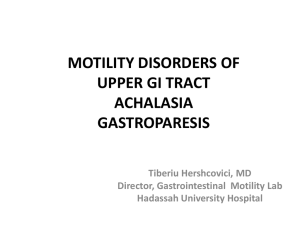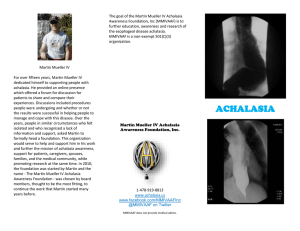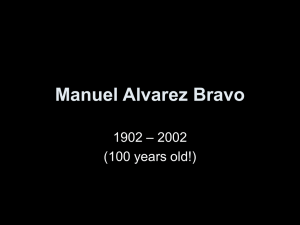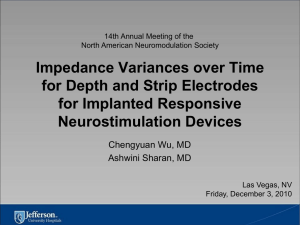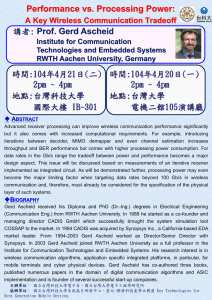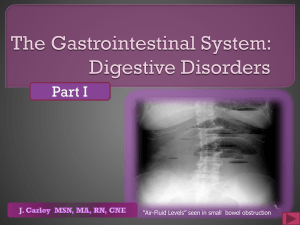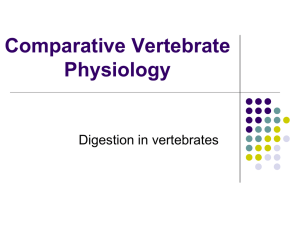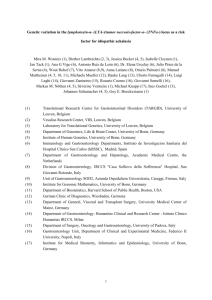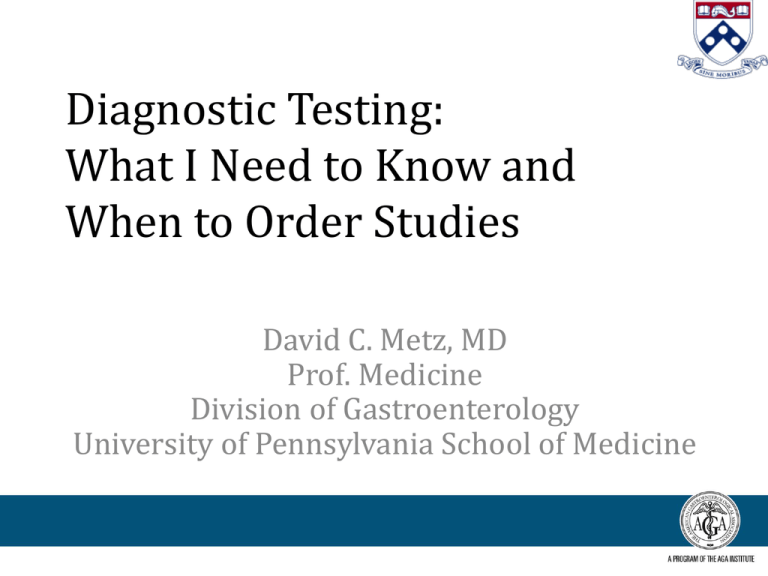
Diagnostic Testing:
What I Need to Know and
When to Order Studies
David C. Metz, MD
Prof. Medicine
Division of Gastroenterology
University of Pennsylvania School of Medicine
35 Year old Woman with
“Refractory GERD”
• 35 year old F with 3 yr history of postprandial
heartburn and regurgitation, intermittent dysphagia
for solids>liquids and mild weight loss
• Initially treated with once daily PPI by her PCP but
failed to respond.
• UGI Xray was normal and her PPI dose was increased
to BID with only a marginal improvement
• EGD with biopsies excluded EoE (and PPI-responsive
eophageal eosinophilia) and she is now referred to
you for “PPI-refractory GERD”
What Could this be and How can
Physiology Testing help?
• Dyspepsia – all in the history (not addressed)
• Inadequately treated GERD –Bravo or catheterbased (imp)/pHmetry
• Achalasia – Hi Res Manometry
• Functional esophageal disease – diagnosis of
exclusion
UGI Physiology Studies
• Ambulatory pH testing
– Catheter (pH plus impedance)
– Bravo (wireless, pH only)
• High resolution manometry with impedance
• Hydrogen breath testing (with methane)
– Overgrowth (Lactulose)
– Dissaccharidase deficiency (Lactose, Fructose, Sucrose)
• Urea breath testing (14C-Urea)
• Others:
– Gastric emptying and Smart Pill
– Gastric analysis and secretin testing
– Small bowel and anal manometry
– Endoflip
Impedance
• Measurement of resistance to flow of current (in
Ohms) between adjacent electrodes along a catheter
• Tolerability similar to standard pHmetry catheters
Impedance: Physics
A Voltage Is Applied Across Ring Set
No bolus = few ions = high impedance
AC
Generator
Intraluminal Ions Support Current Flow
AC
Generator
Bolus present = many ions = low impedance
Impedance During a Normal Swallow
Low Conductivity
Air
I
m
p
e
d
a
n
c
e
Mucosa
Saliva
Food
Gastric Juice
High Conductivity
Measuring Bolus Transit
• By dispersing electrodes along the catheter can
determine:
– Direction of bolus transit (anterograde/retrograde)
– Bolus clearance
– Transit time
• By convention liquid bolus entry is signaled by
50% drop in impedance at the recording site and
exit by return ≥50% of baseline
– Validate with studies using videofluoroscopy and
barium esophagram
Simren et al. Gut 2003
Sifrim et al. Gut 2004
Antegrade (swallow)
Retrograde (reflux)
Ambulatory Impedance-pH Testing:
Reflux Types
Impedance/pH vs. Bravo
Chemical Properties
Acid / weak acid / nonacid
Acid / weak acid only
Physical Properties
Liquid / gas / mix
None
Yes
No
Bolus direction/
presence/height
Tolerability
Duration
Therapy
Less
More
Shorter
Longer
On or Off
Off (or On)
Ambulatory pH
Testing: Bravo
• Catheter free reflux monitoring (wireless
telemetry)
• Contraindicated with implanted electrical
devices, prior bowel resection
• Probe placed 6 cm above the GE junction
• Detects changes in pH only
• 48 to 96 hour study (generally 48 hour)
• Risks: pain, obstruct, no MRI for 4 weeks
Ambulatory pH Testing: Bravo
• Advantages of Bravo
– Patient preference
• 87% of patients preferred Bravo1
– Tolerability
• Less interference with work & daily life1,2
– Prolonged measurement
• Day to day variation; improvement in diagnostic
sensitivity3
• Disadvantages
– Only measures acid; Less useful ON therapy
1
Wenner et al. AJG 2007 2
Grigolon et al. Dig and Liv Dis 2007
3 Fox et al. AJG 2007
Impedance-pH Testing:
Off Therapy Positive
Impedance-pH Testing:
On Therapy Positive
Impedance-pH Testing:
Off Therapy Negative
Bravo Off Therapy: Negative
Bravo Off Therapy: Positive
You elect for an Imp/pHmetry
ON Twice daily PPI
• Esophageal acid exposure is virtually absent
• Gastric acidity is appropriately suppressed
• Non-acidic reflux episodes are well within normal
limits
• The Symptom index is NEGATIVE
– many symptom episodes UNRELATED to GER events
• This is NOT refractory GERD
• Could she have achalasia?
High Resolution Manometry
• 36 channel catheter
spanning entire
esophagus to study all
anatomic zones from
pharynx to stomach
• Converts waveform to
topographic display
• Combined with
impedance
High Resolution Manometry Plot
Hi. Res. Manometry with Impedance
Normal Swallow Followed by a
TLESR
Back to our Patient: Hi Res Mano
Type 1: Classical Achalasia
Absent peristalsis
LES non-relaxation
Type 2:Achalasia with PanEsophageal Pressurization
Pan-esophageal
Pressurization
LES non-relaxation
Type 3:Achalasia with
Esophageal Spasm
Spasm
LES non-relaxation
Simplified Chicago Classification
• Impaired EGJ relaxation
–
–
–
–
Classical Achalasia
Achalasia with esophageal pressurization
Achalasia with spasm
Functional EGJ obstruction (normal peristalsis)
• Normal EGJ relaxation
–
–
–
–
Absent peristalsis (scleroderma, Rxed achalasia)
Hypotensive peristalsis (IEM, GERD, connective tissue)
Hypertensive peristalsis (nutcracker esophagus)
Spasm
Modified from Pandolfino JE, et al. Am J gastroenterol 2007;102:1-11
But the Mano is normal too……..
• Refractory GERD is out
• Achalasia is unlikely too
• Double back and RECONSIDER
– EoE
– Dyspepsia
• If all excluded, need to consider functional
heartburn
Breath Testing
Hydrogen Breath Testing: Normal
Oro-cecal transit time
Lactulose
Hydrogen Breath Testing:
Overgrowth (Lactulose)
Lactulose
Hydrogen Breath Testing:
Dissaccharidase Deficiency
Lactose
Urea Breath Testing (14C-Urea)
Change in Guidelines
• All patients treated for H. pylori infection
require post treatment testing to document
cure status
• Options:
– Non-invasive: UBT, HpSA
– Invasive: Endoscopy and Bx (H+E, IHC, Culture)
– Antibody testing is no longer acceptable
(serologic scar)
Tests of Gastric Emptying
UGI / endoscopy inaccurate
Radio-opaque markers
Radiolabelled solid scintigraphy “gold standard”
“Smart Pill”
Gastroduodenal manometry, octanoic acid, and
ultrasound measures of emptying are
investigational / research techniques
• Electrogastrography measures gastric rhythm
(also investigational / research uses)
•
•
•
•
•
Gastric Emptying Scan:
Gold Standard is a Four Hour Test
Normal residual is
<10% of a standardized
meal at four hours
Feldman, M. Sleisenger & Fordtran's Gastrointestinal and Liver Disease; 2007
SmartPillTM for Gastric Emptying
Ingestible capsule that measures pH, pressure and temperature using
miniaturized wireless sensor technology – measures whole gut transit
Courtesy Henry Parkman, MD
Conclusions
• GI Physiology testing helps in the diagnosis
and management of patients with nonstructural diseases of the upper (and lower)
GI tract
• In general should be performed AFTER
(normal) structural studies have been done
• Best to target testing to presenting
symptoms


